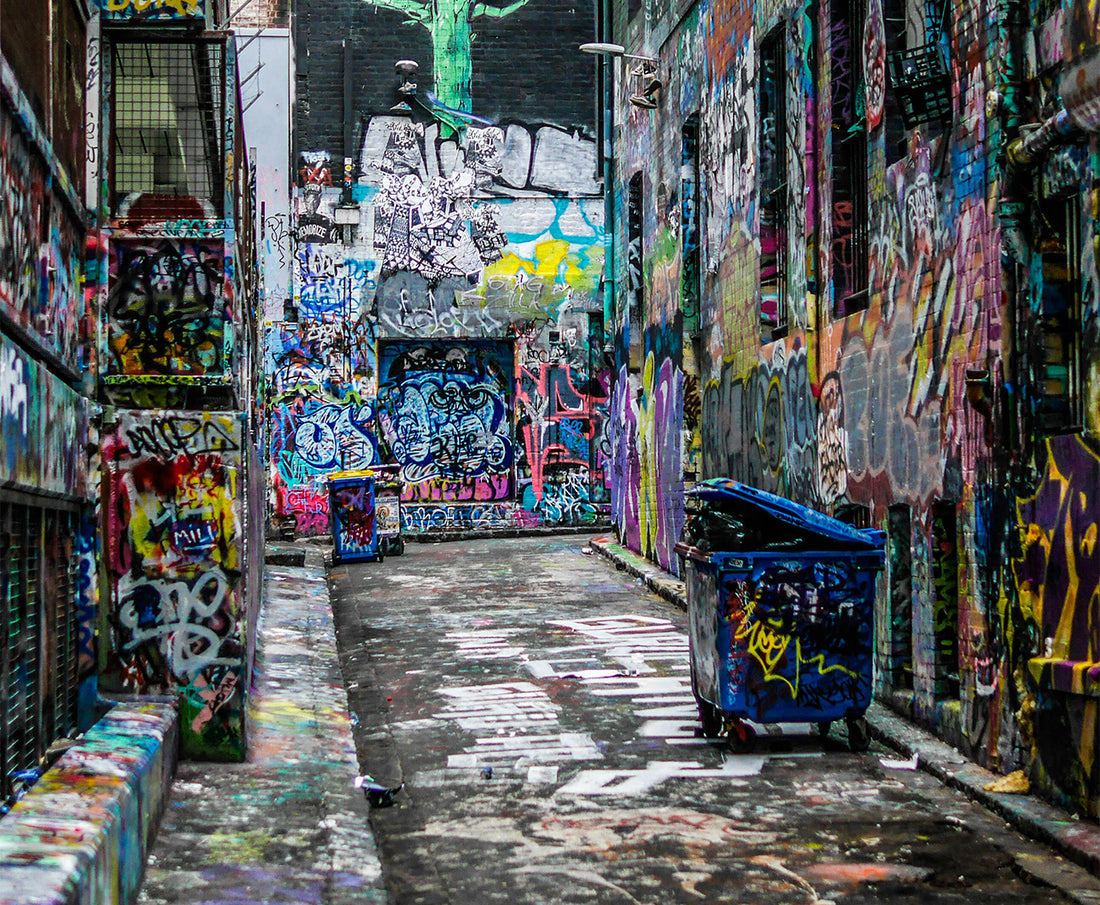
The Influence of Street Art
Share
In a recent blog I have stated how I like to create a lot of my art to include a message or to provoke the viewer and to raise questions. One of the main influences on this has been street art and its approach to expression, social commentary and pushing the boundaries of what is acceptable.
Once considered vandalism, Street Art, traditionally is a form of visual art created in public spaces, using a variety of media such as spray paint, stencils, and stickers. It is typically intended to convey a message or provoke thought, often challenging social norms and political systems. Street art can be found in urban environments around the world, from large-scale murals on building walls to small, hidden pieces in alleyways.
It is a medium that allows artists to express themselves freely and engage with the public in unexpected ways and has now significantly influenced mainstream art and culture.
Its raw, unfiltered expression has inspired contemporary artists and designers, leading to a fusion of street art techniques with traditional art forms. Galleries and museums now showcase street art, acknowledging its artistic value and social commentary. The rise of street art festivals and public art projects has further integrated this art form into mainstream culture, making it accessible to a wider audience, and challenging traditional notions of art, democratizing the creative process and promoting inclusivity, diversity, and social awareness within the art world.

Love won't Tear Us Apart by D*Face
Some of the most famous street artists include:
- **Banksy**: Known for his politically charged and thought-provoking stencilled works, Banksy's identity remains a mystery, adding to his allure. His works often feature satirical social commentary and have gained worldwide recognition.
- **Shepard Fairey**: Fairey is known for his "Obey Giant" campaign and the iconic Barack Obama "Hope" poster. His street art often incorporates political themes and is recognized for its bold graphic style.
- **JR**: A French artist known for his large-scale photographic works, JR's projects aim to challenge societal stereotypes and highlight human faces and stories in unexpected places.
- **Keith Haring**: Haring's colorful, cartoonish figures and bold lines became synonymous with 1980s New York City Street culture. His works often conveyed messages of social activism, including AIDS awareness.
- **Jean-Michel Basquiat**: While primarily known for his paintings, Basquiat started as a street artist under the pseudonym SAMO. His graffiti art often featured cryptic messages and symbols, reflecting his fascination with language and identity.
Banksy is a pseudonymous England-based Street artist from the city of Bristol. His work has a great influence on me. Not so much in style, but in the way he makes the public think through comical social commentary. His satirical street art and subversive epigrams combine dark humour with graffiti, often critiquing contemporary politics, consumerism, and society's treatment of the environment and social justice issues.

Girl with a Balloon by Banksy
Executed in a distinctive stencilling technique, Banksy's works have been featured on streets, walls, and bridges in cities throughout the world. Notable pieces include "Girl with a Balloon," and "The Flower Thrower," a mural depicting a masked protester throwing a bouquet of flowers.
With murals, stencils, and installations often addressing issues such as war, poverty, and environmental degradation. They also examine themes like privacy, surveillance, and the power dynamics between governments and individuals. Banksy's art often features recurring motifs, such as rats, monkeys, and children, which serve as symbols for broader societal issues. His pieces frequently challenge viewers to question their assumptions and consider alternative perspectives on contemporary issues.
Another famous artist, Jean-Michel Basquiat, also began his artistic career as a street artist in the late 1970s under the pseudonym SAMO alongside AI Diaz. Their graffiti, which often featured cryptic messages and symbols, could be found on walls and buildings throughout downtown Manhattan. Basquiat's work was influenced by his background in graffiti and street art, as well as his interest in contemporary art and music. His street art often incorporated a mix of text and imagery, ranging from social commentary to self-expression, laying the foundations for his later success as a painter.
In contemporary art the influence of street art can be most evident in the Pop Art of today. The overlap of street art and pop art in modern art is evident in their shared themes of popular culture, consumerism, and social commentary. Both movements incorporate imagery from mass media and everyday life, blurring the lines between high and low art. Artists like Shepard Fairey, and Mr. Brainwash have emerged as prominent figures in the intersection of street art and pop art, creating works that challenge traditional notions of art and engage with contemporary issues.
Its this overlap and acceptance of street art as a legitimate art form that has led to the influence in my work. I may not use spray paints or stencils, but the foundational messages and commentary on social issues is built into what I do. Alongside this I also like to incorporate humour in a similar manner to Banksy and other street artists. Admittedly, this humour may be of the darkest kind, but there is a togue in the cheek element to a lot of my work. Ultimately it is important for me to use my art as voice to convey the messages that are important to me.

Educations for future generations by Tell Tall Tales




